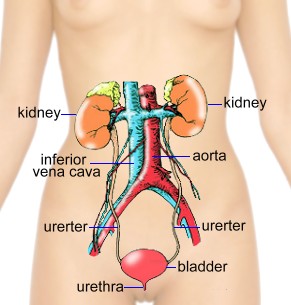 The urinary system is composed of organs, tubes, muscles, and nerves that work together to dispose of wastes in the body, and to help keep the chemicals and water in your body in balance. The urinary system includes two kidneys, two ureters, the bladder, two sphincter muscles, and the urethra. Your body absorbs nutrients from the food you eat. What's left is waste, and is left behind in the bowel and the blood. The urinary system removes a type of waste called urea from your blood. Urea is produced when foods containing protein, are broken down in the body. Urea is carried in the bloodstream to the kidneys.  The kidneys are organs about the size of your fists, and are are near the middle of the back, just below the rib cage. The kidneys filter urea from the blood, while about 99% of the fluid in food is returned to the body. The kidneys allow the blood to keep glucose, salts and minerals. The kidneys are organs about the size of your fists, and are are near the middle of the back, just below the rib cage. The kidneys filter urea from the blood, while about 99% of the fluid in food is returned to the body. The kidneys allow the blood to keep glucose, salts and minerals. After the urea has been filtered out it is mixed with water and other waste substances (excess salts and organic materials) and becomes urine. The waste-containing urine is sent from the kidneys down two thin tubes called ureters to the bladder. Muscles in the ureter walls repeatedly contract and relax to force urine downwards. Small amounts of urine are emptied into the bladder from the ureters about every 15 seconds. The bladder is a hollow organ shaped like a balloon. It sits in your pelvis where it is held in place by ligaments attached to the pelvic bones. The bladder stores urine until you are ready to empty it. It swells into a round shape when it is full. In a healthy urinary system, the bladder can hold up to half a litre of urine comfortably for several hours. Circular muscles called sphincters help keep the urine from leaking out; they close tightly like a rubber band around the opening into the urethra. When you urinate, the brain signals the bladder muscles to tighten, squeezing urine out of the bladder, and also signals the sphincter muscles to relax. Urine exits the bladder through the urethra, a tube which exits at the vagina (in females) and through the penis (in males). Adults eliminate about a litre and a half of urine each day, although this can vary depending on how much fluid you have taken in and how much you've been sweating. The body also uses the kidneys to keep the amount of water in your body in balance. If you've been drinking lots of liquids and have excess water, it will be passed out in the urine, making the urine very pale in colour. Alternately, if you haven't been drinking enough fluids, the kidneys will conserve water by mixing less into the urine, making it appear dark yellow. Urine is sterile and nearly odourless when it leaves a healthy body. But once outside, urine is quickly contaminated by bacteria which convert chemicals in the urine into other chemicals that have a distinctive odour, one of which is ammonia. Some diseases alter the characteristics urine. For example, sugar in the urine is a sign of diabetes. Problems in the urinary system include kidney failure, urinary tract infections, kidney stones, prostate enlargement, and bladder control problems. Kidney failure is not necessarily fatal; less than half of one single kidney can do all the work that two kidneys usually do. Interesting Urine Facts:
|